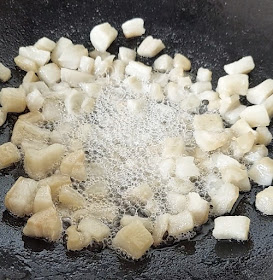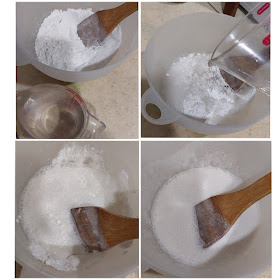黄梨挞 / 凤梨酥
Pineapple is called "Ong Lai" in Hokkien dialect, literally translated as "Prosperity Come". To welcome Chinese New Year, many Chinese families would thus love to have pineapple tarts. These tarts are symbols of prosperity, good luck and good fortune.
Homemade pineapple tarts are the best as we can control the sourness or sweetness of the pineapple jam, as well as how buttery we want the pastry crust to be. Here is my version of buttery and melt in the mouth pineapple tarts.
Pineapple Jam
(one fresh ripe pineapple makes 6g fillings for about 30 tarts)
(2 pineapples weighing 2.44kg makes 461g jam.)
Cut the pineapple skin and remove the 'eyes' from the flesh. Cut the pineapple into big wedges. Do not cut away the core or hard stem in the centre at this moment as it will facilitate grating.
Grate the pineapple and discard the core/hard stem.
Cook the pineapple flesh together with the juices in a wok over medium-low heat. I did not add spices like cloves or cinnamon as I just want pure pineapple fragrance. Stir from time to time until the juices have reduced. Once 75% of the juices have evaporated, add rock sugar or granulated sugar according to how ripe the pineapples are (approximately 30g to 50g per pineapple), and stir the pineapple flesh frequently to avoid burning the jam. Note: Optionally, can add lemon juice which acts as a natural preservative (around 1 tsp per pineapple) and/or maltose (1 tsp per pineapple). Once the jam has thickened (i.e. can stick to the spatula) and golden brown in colour, the jam is done. It takes about 2.5 hours (from cutting, grating to cooking) for the pineapple jam to be ready. Store the jam in a sterilised air tight container once it has completely cooled down.
Roll the jam into balls of 6g each, and keep in fridge.
Note: Because homemade pineapple jam does not contain preservatives and usually uses lesser sugar, they cannot last too long. So it is best to make the jam as well as the pineapple tarts one week before Chinese New Year.
Pineapple Tart Pastry
Ingredients (makes about 35 tarts of 10g dough each):
125g unsalted butter (soft to the touch, around 20 degree celcius) - I use Golden Churn brand butter.
180g plain flour
10g corn starch (1 tablespoon)
1 egg yolk (15g)
20g icing sugar
1/8 tsp salt
1 spoonful of love
Method:
1. Sieve plain flour and corn starch together and set aside.
2. Whisk the butter in mixing bowl, then add icing sugar and whisk until the butter is pale/white in colour. This takes about 2 to 3 minutes of hand whisking.
3. Add salt and egg yolk, and whisk until just combined.
4. Add in sieved flour and use spatula to mix using cutting and folding motion. Stop mixing when there are no more flour. Lift dough and throw back into mixing bowl for 5 times. Overmixing will cause the dough to be hard. Lightly press the dough with your finger, and if it does not stick to your hand, rest dough in fridge for 30mins and it is ready. From here, you can either do an open faced pineapple tart or round shaped (ball) tarts.
Open Faced Tarts
5a. Place the dough on a lightly floured bench, and roll it to 5mm thickness. Lightly flour the pineapple tart cutter, cut the dough carefully and place in a baking tray.
6a. Egg wash the tarts and bake them at 180 degree celcius for 10 mins. Remove from oven and place the balls of pineapple jam on each tart. Return the tray to the oven and continue to bake for another 10 mins. Once the tart is golden in colour, remove the tray from the oven and lightly press on the pineapple balls so that the jam will stick to the tart.
Round Shaped Tarts
5b. Weigh the dough and ensure each is 9g each. Roll into ball, flatten it and place the pineapple jam ball in the middle. Bring the edges of the dough together and seal. Gently roll it in between your palms to shape it into a ball. Optional: Score criss-cross pattern to resemble pineapple skin on the ball using scrapper to make them look like pineapples!
6b. Bake the tarts at 160C (fan mode) for 8minutes. Then, glaze the top of the tart with egg wash (1 egg yolk + 1 teaspoon of milk or half teaspoon cooking oil) and bake at 150C for another 10-12minutes (without fan mode) or until tarts are golden brown.
7. Cool completely before storing the tarts in containers. To prevent the tarts from sticking to each other, lay a piece of baking paper liner between each layer of tarts.
For nastar shape:
Put the dough into nastar piping tip, and then press out into a strip of 5cm length.
Place pineapple filing at one end and roll up the pastry, as in a Swiss roll, enough to enclose the jam. Do not overlap the pastry. Cut off the excess pastry.


















































